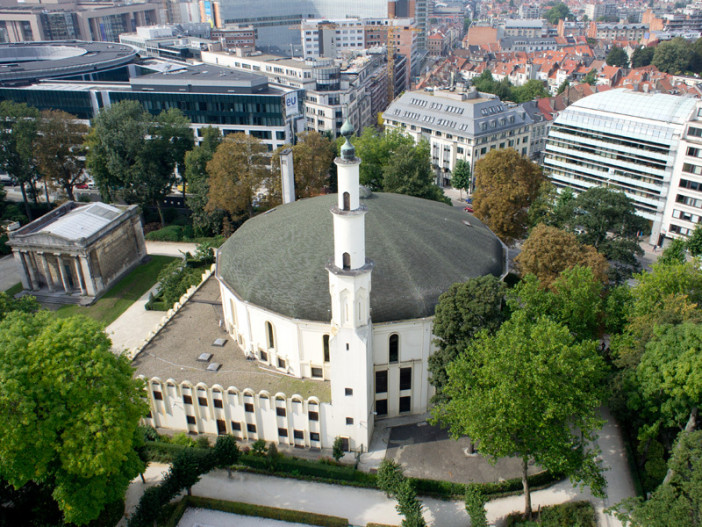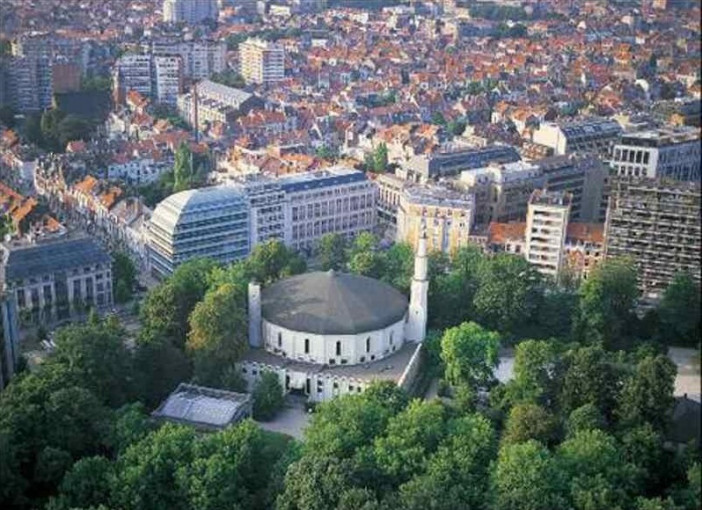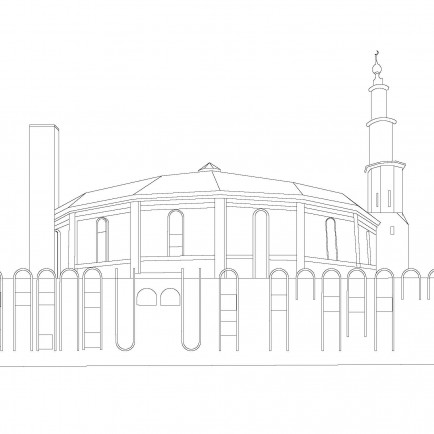Grand Mosque of Brussels (Islamic and Cultural Center of Belgium)
History
The original building was built by architect Ernest Van Humbeeck in an Arabic style, to form the Oriental Pavilion of the National Exhibition in Brussels in 1880. At that time the pavilion housed a monumental painting on canvas: “Panorama of Cairo”, by the Belgian painter Emile Wauters, which enjoyed major success. However, lack of maintenance in the twentieth century caused the building to gradually deteriorate.
In 1967, King Baudouin lent the building to King Faisal ibn Abd al-Aziz of Saudi Arabia with a 99-year rent-free lease, on an official visit to Belgium as part of negotiations to secure oil contracts. The building was turned into a place of worship for the use of Muslim immigrants to Belgium, who at the time were notably from Morocco and Turkey.As part of the deal, imams from the Gulf area would be hired, although their orthodox salafism was a tradition, according to Georges Dallemagne, different from that of the more open-minded immigrants but their teachings would over time turn them into a more orthodox tradition and imams would discourage immigrants from integrating into the Belgian society, according to Georges Dallemagne.The mosque, after a long reconstruction carried out at the expense of Saudi Arabia by Tunisian architect Mongi Boubaker, was inaugurated in 1978 in the presence of Khalid ibn Abd al-Aziz and Baudouin.
Description
The Great Mosque of Brussels is the oldest mosque in Brussels. It is located in the Cinquantenaire Park. It is also the seat of the Islamic and Cultural Centre of Belgium. The original building was built by architect Ernest Van Humbeek in an Arabic style, to form the Oriental Pavilion of the National Exhibition in Brussels in 1880. At that time the pavilion housed a monumental painting on canvas: “Panorama of Cairo”, by the Belgian painter Emile Wauters, which enjoyed major success. However, lack of maintenance in the twentieth century caused the building to deteriorate gradually.
The Mosque's role as the leading religious institution within the Belgian Islamic community—as well as its intended role as a diplomatic bridge between the Saudi and Belgian monarchies—has been a point of debate since its re-foundation. The mosque is popular with Muslim diplomats and is a popular location for Belgians seeking to convert to Islam. It has also taught thousands of Muslim students.
In February 2018 Saudi Arabia agreed to give up control of the mosque in a sign that it is trying to shed its reputation as a global exporter of an ultra-conservative brand of Islam.
On 16 March 2018, the Council of Ministers of Belgium decided to end the concession and transfer its exploitation to the Muslim Executive of Belgium and a charity of local believers. A transition period of one year was decided, enabling to create a structure that will associate the Muslim Executive and the yet to form association. The government thus enacts a recommendation of the commission investigating the 2016 Brussels bombings that aimed at ending interference of foreign states in the Islam taught in Belgium.
Today, it also hosts a school and an Islamic research centre whose objectives are to propagate the Muslim faith. The centre also provides courses of Arabic for adults and children, as well as introductory courses in Islam.
References
https://en.wikipedia.org/wiki/Great_Mosque_of_Brussels
https://www.beautifulmosque.com/Great-Mosque-in-Brussels-Belgium
https://www.google.com/search?q=great+mosque+brussels&tbm=isch&ved=2ahUKEwiD5crNzNvrAhVzwAIHHc2CDoAQ2-cCegQIABAA&oq=great+mosque+brussels&gs_lcp=CgNpbWcQAzIECCMQJzIGCAAQCBAeUMXuCFjF7ghg7fAIaABwAHgAgAE-iAE-kgEBMZgBAKABAaoBC2d3cy13aXotaW1nwAEB&sclient=img&ei=p4pYX8P1H_OAi-gPzYW6gAg&bih=625&biw=1366&rlz=1C1CHBF_enNL874NL874#imgrc=oMarvVEBEq5J1M
Details
Location
Parc du Cinquantenaire 14, 1000 Bruxelles, Belgium
Owners
Muslim World League
Year of Build
1879
Drawings
Map
History
The original building was built by architect Ernest Van Humbeeck in an Arabic style, to form the Oriental Pavilion of the National Exhibition in Brussels in 1880. At that time the pavilion housed a monumental painting on canvas: “Panorama of Cairo”, by the Belgian painter Emile Wauters, which enjoyed major success. However, lack of maintenance in the twentieth century caused the building to gradually deteriorate.
In 1967, King Baudouin lent the building to King Faisal ibn Abd al-Aziz of Saudi Arabia with a 99-year rent-free lease, on an official visit to Belgium as part of negotiations to secure oil contracts. The building was turned into a place of worship for the use of Muslim immigrants to Belgium, who at the time were notably from Morocco and Turkey.As part of the deal, imams from the Gulf area would be hired, although their orthodox salafism was a tradition, according to Georges Dallemagne, different from that of the more open-minded immigrants but their teachings would over time turn them into a more orthodox tradition and imams would discourage immigrants from integrating into the Belgian society, according to Georges Dallemagne.The mosque, after a long reconstruction carried out at the expense of Saudi Arabia by Tunisian architect Mongi Boubaker, was inaugurated in 1978 in the presence of Khalid ibn Abd al-Aziz and Baudouin.
Description
The Great Mosque of Brussels is the oldest mosque in Brussels. It is located in the Cinquantenaire Park. It is also the seat of the Islamic and Cultural Centre of Belgium. The original building was built by architect Ernest Van Humbeek in an Arabic style, to form the Oriental Pavilion of the National Exhibition in Brussels in 1880. At that time the pavilion housed a monumental painting on canvas: “Panorama of Cairo”, by the Belgian painter Emile Wauters, which enjoyed major success. However, lack of maintenance in the twentieth century caused the building to deteriorate gradually.
The Mosque's role as the leading religious institution within the Belgian Islamic community—as well as its intended role as a diplomatic bridge between the Saudi and Belgian monarchies—has been a point of debate since its re-foundation. The mosque is popular with Muslim diplomats and is a popular location for Belgians seeking to convert to Islam. It has also taught thousands of Muslim students.
In February 2018 Saudi Arabia agreed to give up control of the mosque in a sign that it is trying to shed its reputation as a global exporter of an ultra-conservative brand of Islam.
On 16 March 2018, the Council of Ministers of Belgium decided to end the concession and transfer its exploitation to the Muslim Executive of Belgium and a charity of local believers. A transition period of one year was decided, enabling to create a structure that will associate the Muslim Executive and the yet to form association. The government thus enacts a recommendation of the commission investigating the 2016 Brussels bombings that aimed at ending interference of foreign states in the Islam taught in Belgium.
Today, it also hosts a school and an Islamic research centre whose objectives are to propagate the Muslim faith. The centre also provides courses of Arabic for adults and children, as well as introductory courses in Islam.






